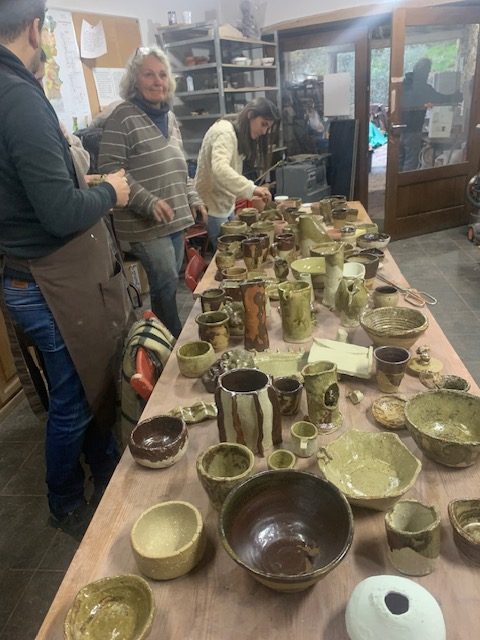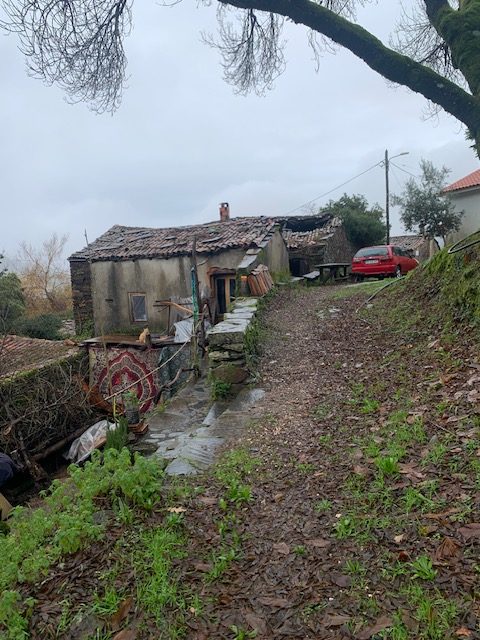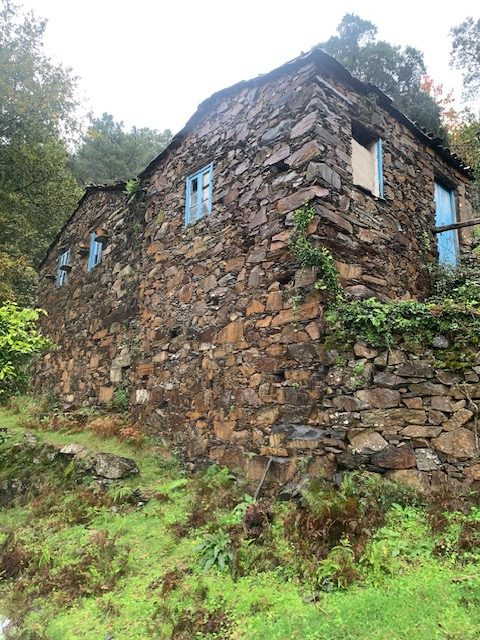It is the beginning of December and it seems the fine weather is over here in the Serra da Lousã. I blame the full moon.
It is raining sideways, downwards and even upwards, as column after column of cloud drifts through the valley and up over the ridge. The phenomenon is called chuva tocava do vento — rain touched by the wind.
Cerdeira seems to huddle down under its trees, each house clutching onto its neighbour for shelter. Warmth and sustenance are found at the café, at the unavoidable conjunction of the two meandering paths which form a kind of chromosomal X.
The back door of my cottage opens onto the short strand of the X chromosome, the front onto its long strand where I often cross paths with a bearded, well-fed local man, described to me as Bernard. This day he is not tinkering with the house I call Casa Azul, after its turquoise-trimmed windows, though the chuva tocava do vento is having a grand time infiltrating the broken ones.
On fine days, he sometimes climbs a rickety ladder from the ground floor, up to a top floor window is protected by a piece of sacking. There is no appreciable improvement to the building after these ladder investigations.
One sunny day, coinciding with the greatest of Bernard’s alpine activities, I had tied my freshly-washed undergarments onto the page-wire fence in front of our two houses, mistakenly believing the house to be unoccupied. I was far across the valley when I spotted his red shirt lumbering up and down the vertical of our shared patch and with it the realization that my impromptu al fresco display of cuecas e sutiãs was ill-advised.
My house has a hand-made cantâro or water jug, with a note inviting me to fill it from the village spring, source of the freshest, purest water in the area. After several days of drinking the obligatorily-chlorinated water, I gave in and headed to the spring to fill my jug with the delicious nectar. I met Bernard twice on my orbit to the font, and he graciously pretended not to notice my underthings. I wished I could have carried the jug on my head, in traditional style, as I ascended back up the path, maybe with a little swagger of my hips, to indicate that I really didn’t give a damn.
The workers who came every fine day to work on a large house further up the path left abruptly the morning the rain started and didn’t come back. I didn’t blame them, though I missed seeing them drive their crazy motorized wheelbarrow, sensibly equipped with caterpillar tracks, up the hill every morning.
Bernard also disappeared.
The wet shale was mercilessly slippery, even on the split blocks laid on their short side, forming a kind of cross-cut pattern for traction. I used my hiking poles even for the briefest of downhill excursions or circumnavigated the village using a longer series of muddy side paths. To do this I had to open Bernard’s gate (if it is Bernard’s?), head down a dirt path and pass over a three-plank-wide makeshift bridge over a roaring stream. Anything to avoid cracking my head open on the unforgiving stone.
My renovated house, Casa do Forno, was snug, plastered white inside with well- fitting (though only single-glazed) windows, heat, lights and a new roof. But life in the aldeias in winter was not so inviting for most people. Only the more well-off could afford a snug-build house, plastered inside and out. The less fortunate made do with leaky, dank houses purposely fitted with small openings to let the
accumulated moisture out.
After two tries in the damp weather, I gave up on my wood stove. The swirling winds made it difficult for the chimney to draw the smoke up and away. My casa had two hearths, the one on the upper floor having served as the village bread oven. No doubt the original inhabitants waged similar battles with wind and fog.
A fire perpetually burning in the lareira would have been essential for warmth and humidity control.
Climbing up path toward the hill above the village, I looked down on Bernard’s house and notice a small solar panel linked to several strands of electric fence, protecting the wall of his tumbledown house, and his yard There appeared to be no threat of intrusion from either man or beast, and I couldn’t help but wonder at his strange precaution. Unless, of course, it was an anti-underwear detector.
Buying and restoring
Still thinking of moving to a schist village? Me too! As I was writing this piece, I checked out Pure Portugal’s (www.pureportugal.co.uk) property listings using “xisto” as a keyword and boom! I found a darling schist house, in xisto village, with a separate chunk of well-watered land. Despite my better judgement, I fell in
love with “SLATE COTTAGE WITH TWO COURTYARDS LOCATED IN AN UNSPOILED VILLAGE” and “STONE SLATE COTTAGE FOR RENOVATION ON 3.5HA OF LAND.”
Most villages are remote and I worried my enthusiasm for living in such a rustic spot might soon wear thin. I gave myself a stern talking-to, even as my heart fluttered away to the pretty ruin in the hills.
There is usually a steep, single-lane access road leading to the village. You may not be able to park anywhere near your property, which means carrying everything– groceries, furniture, major appliances–to your front door. Public transit, a post office and home garbage collection are unlikely.
Expect close contact with your neighbours, if there are any. While some villages are relatively large and well-tended, others are are small, with only a handful of inhabitants and many abandoned and decaying houses. I saw only a few Vende-se signs, all of them on pitiful ruins.
Sometimes, property negotiations with numerous heirs makes the purchase impossible. Use a lawyer, and secure a habitation license and planning permit beforehand. Rustic land is difficult to convert to residential use. You may need to use an architect for re-design, and an engineer may also be needed to work
out the logistics of rebuilding a hillside dwelling.
It is best to hire a specialized restoration firm to rebuild the schist stone properly. Not all schist villages are made entirely of schist. Materials used may include quartzite or granite, depending on location to include quartzite or granite. The exterior stone may be plastered or left exposed. The ideal village has something happening, such as arts courses, restaurants, cafés, some permanent inhabitants, and easy access to a major town with shops, grocery stores, and other services. It’s something to keep in mind when you feel
your heartstrings tugged by a tumbledown pile of stones.
Thanks again for this fabulous blog from Leslie Smith



Photo credit: Leslie Smith
1. Activities in a lively village, with Cerdeira founder Kerstin Thomas, centre
2. Life in a deserted village
3. Casa Azul, Cerdeira





